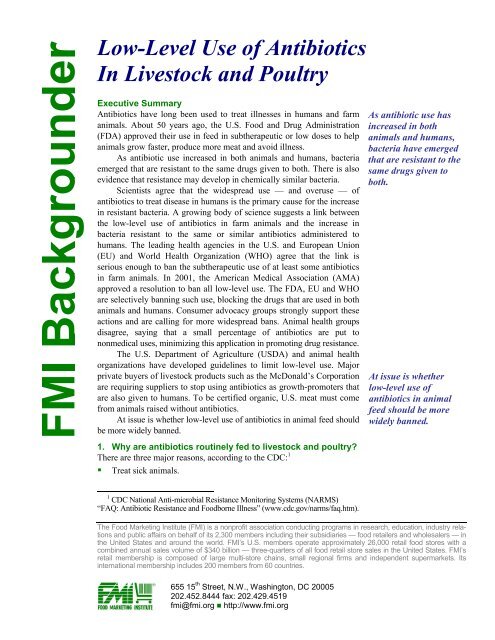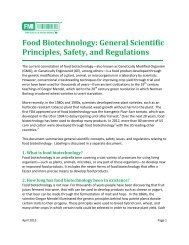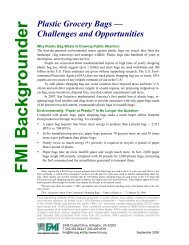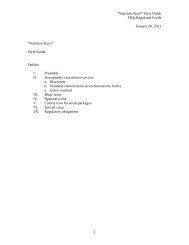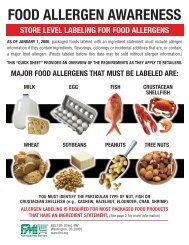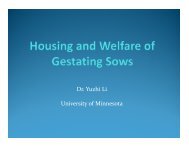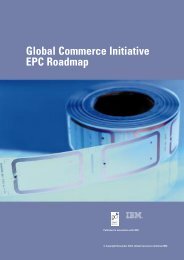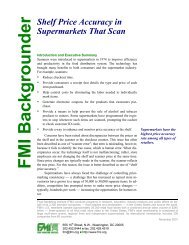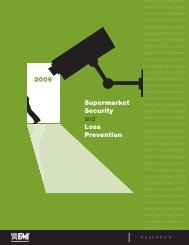Low-Level Use of Antibiotics In Livestock and Poultry
Low-Level Use of Antibiotics In Livestock and Poultry
Low-Level Use of Antibiotics In Livestock and Poultry
Create successful ePaper yourself
Turn your PDF publications into a flip-book with our unique Google optimized e-Paper software.
<strong>Low</strong>-<strong>Level</strong> <strong>Use</strong> <strong>of</strong> <strong>Antibiotics</strong><br />
<strong>In</strong> <strong>Livestock</strong> <strong>and</strong> <strong>Poultry</strong><br />
Executive Summary<br />
<strong>Antibiotics</strong> have long been used to treat illnesses in humans <strong>and</strong> farm<br />
animals. About 50 years ago, the U.S. Food <strong>and</strong> Drug Administration<br />
(FDA) approved their use in feed in subtherapeutic or low doses to help<br />
animals grow faster, produce more meat <strong>and</strong> avoid illness.<br />
As antibiotic use increased in both animals <strong>and</strong> humans, bacteria<br />
emerged that are resistant to the same drugs given to both. There is also<br />
evidence that resistance may develop in chemically similar bacteria.<br />
Scientists agree that the widespread use — <strong>and</strong> overuse — <strong>of</strong><br />
antibiotics to treat disease in humans is the primary cause for the increase<br />
in resistant bacteria. A growing body <strong>of</strong> science suggests a link between<br />
the low-level use <strong>of</strong> antibiotics in farm animals <strong>and</strong> the increase in<br />
bacteria resistant to the same or similar antibiotics administered to<br />
humans. The leading health agencies in the U.S. <strong>and</strong> European Union<br />
(EU) <strong>and</strong> World Health Organization (WHO) agree that the link is<br />
serious enough to ban the subtherapeutic use <strong>of</strong> at least some antibiotics<br />
in farm animals. <strong>In</strong> 2001, the American Medical Association (AMA)<br />
approved a resolution to ban all low-level use. The FDA, EU <strong>and</strong> WHO<br />
are selectively banning such use, blocking the drugs that are used in both<br />
animals <strong>and</strong> humans. Consumer advocacy groups strongly support these<br />
actions <strong>and</strong> are calling for more widespread bans. Animal health groups<br />
disagree, saying that a small percentage <strong>of</strong> antibiotics are put to<br />
nonmedical uses, minimizing this application in promoting drug resistance.<br />
The U.S. Department <strong>of</strong> Agriculture (USDA) <strong>and</strong> animal health<br />
organizations have developed guidelines to limit low-level use. Major<br />
private buyers <strong>of</strong> livestock products such as the McDonald’s Corporation<br />
are requiring suppliers to stop using antibiotics as growth-promoters that<br />
are also given to humans. To be certified organic, U.S. meat must come<br />
from animals raised without antibiotics.<br />
At issue is whether low-level use <strong>of</strong> antibiotics in animal feed should<br />
be more widely banned.<br />
As antibiotic use has<br />
increased in both<br />
animals <strong>and</strong> humans,<br />
bacteria have emerged<br />
that are resistant to the<br />
same drugs given to<br />
both.<br />
At issue is whether<br />
low-level use <strong>of</strong><br />
antibiotics in animal<br />
feed should be more<br />
widely banned.<br />
1. Why are antibiotics routinely fed to livestock <strong>and</strong> poultry<br />
There are three major reasons, according to the CDC: 1<br />
• Treat sick animals.<br />
1 CDC National Anti-microbial Resistance Monitoring Systems (NARMS)<br />
“FAQ: Antibiotic Resistance <strong>and</strong> Foodborne Illness” (www.cdc.gov/narms/faq.htm).<br />
The Food Marketing <strong>In</strong>stitute (FMI) is a nonpr<strong>of</strong>it association conducting programs in research, education, industry relations<br />
<strong>and</strong> public affairs on behalf <strong>of</strong> its 2,300 members including their subsidiaries — food retailers <strong>and</strong> wholesalers — in<br />
the United States <strong>and</strong> around the world. FMI’s U.S. members operate approximately 26,000 retail food stores with a<br />
combined annual sales volume <strong>of</strong> $340 billion — three-quarters <strong>of</strong> all food retail store sales in the United States. FMI’s<br />
retail membership is composed <strong>of</strong> large multi-store chains, small regional firms <strong>and</strong> independent supermarkets. Its<br />
international membership includes 200 members from 60 countries.<br />
655 15 th Street, N.W., Washington, DC 20005<br />
202.452.8444 fax: 202.429.4519<br />
fmi@fmi.org • http://www.fmi.org
<strong>Low</strong>-<strong>Level</strong> <strong>Use</strong> <strong>of</strong> <strong>Antibiotics</strong> in <strong>Livestock</strong> <strong>and</strong> <strong>Poultry</strong><br />
• Prevent disease among animals susceptible to infections. This use<br />
affects a larger number <strong>of</strong> animals, because it usually involves<br />
treating a whole herd or flock, which increases the likelihood <strong>of</strong><br />
genetic selecting for organisms that are resistant to the antibiotic.<br />
• Promote the growth <strong>of</strong> cattle, poultry <strong>and</strong> swine when they are fed low<br />
doses for long periods. As a growth-promoter, antibiotics in feed help<br />
animals gain weight more efficiently by controlling the bacteria that<br />
can interfere with their ability to absorb nutrients. Animals become<br />
healthier, grow faster <strong>and</strong> stronger, <strong>and</strong> fewer die from disease.<br />
2. Are drug residues in food the issue<br />
No. USDA routinely inspects meat, poultry <strong>and</strong> egg products for residues<br />
that exceed tolerance levels. The inspectors seldom find residues that<br />
exceed safe levels. The issue here involves antibiotic resistance <strong>of</strong><br />
bacteria, not antibiotic residues.<br />
It is also important to underst<strong>and</strong> that resistance has nothing to do<br />
with potency. The resistant bacteria are not stronger; they simply cannot<br />
be treated with antibiotics that are currently available.<br />
3. Why has antibiotic resistance increased in humans<br />
It is widely accepted that the primary cause is overuse <strong>and</strong> misuse <strong>of</strong><br />
antibiotics. <strong>In</strong> some cases, doctors prescribe or patients dem<strong>and</strong> the drugs<br />
too frequently or inappropriately, such as for illnesses that are not caused<br />
by bacteria <strong>and</strong> do not respond to antibiotics. <strong>In</strong> other cases, patients fail<br />
to complete the prescribed course <strong>of</strong> an antibiotic treatment, making it<br />
more likely that surviving bacteria will develop resistance to the drug.<br />
There is also evidence that antibiotic use in food-producing animals<br />
contributes to human drug resistance, although to a far lesser degree than<br />
human use does. The controversy centers over how significant this<br />
contribution is, how much <strong>of</strong> the problem stems from subtherapeutic use<br />
<strong>and</strong> how to respond.<br />
4. What triggered the controversy<br />
The issue emerged in 1984 when a CDC study linked antibiotics in<br />
livestock <strong>and</strong> poultry feed to resistant bacteria in humans. 2 The issue<br />
resurfaced in the 1990s with reports about the emergence <strong>of</strong> antibioticresistant<br />
strains <strong>of</strong> Salmonella, Campylobacter <strong>and</strong> E. coli O157:H7.<br />
CDC reported an increase in resistance in laboratory samples from 0.6<br />
percent in 1979 to 34 percent in 1996. 3 The study noted that a serotype <strong>of</strong><br />
Salmonella known as DT104 is resistant to five antibiotics <strong>and</strong> has<br />
become a major cause <strong>of</strong> illness in humans <strong>and</strong> animals in Europe,<br />
especially in the United Kingdom.<br />
A Minnesota study linked an increase in quinolone-resistant<br />
Campylobacter jejuni infections from 1992 through 1998 to the licensing<br />
As a growth promoter,<br />
antibiotics in feed help<br />
animals gain weight<br />
more efficiently by<br />
controlling the bacteria<br />
that can interfere with<br />
their ability to absorb<br />
nutrients.<br />
The issue here involves<br />
antibiotic resistance <strong>of</strong><br />
bacteria, not antibiotic<br />
residues.<br />
The issue emerged in<br />
1984 when a CDC study<br />
linked antibiotics in<br />
livestock <strong>and</strong> poultry<br />
feed to resistant bacteria<br />
in humans.<br />
2 “Drug-Resistant Salmonella From Animals Fed Antimicrobials,” New Engl<strong>and</strong><br />
Journal <strong>of</strong> Medicine, September 6, 1984.<br />
3 “Emergence <strong>of</strong> Multidrug-Resistant Salmonella enterica Serotype Typhimurium<br />
DT104 <strong>In</strong>fections in the United States,” New Engl<strong>and</strong> Journal <strong>of</strong> Medicine,<br />
May 7, 1998.<br />
Food Marketing <strong>In</strong>stitute 2
<strong>Low</strong>-<strong>Level</strong> <strong>Use</strong> <strong>of</strong> <strong>Antibiotics</strong> in <strong>Livestock</strong> <strong>and</strong> <strong>Poultry</strong><br />
<strong>of</strong> fluoroquinolones for use in livestock <strong>and</strong> poultry. 4 FDA approved<br />
these drugs in 1995 to prevent bacterial diseases in poultry. The report<br />
cited Minnesota Health Department data showing that Campylobacter<br />
became increasingly resistant to a fluoroquinolone. The resistant bacteria<br />
were found in samples from people suffering from foodborne illness.<br />
A 2001 study cited the appearance <strong>of</strong> bacteria resistant to the drug<br />
Synercid (quinupristin/dalfopristin) in patients who had never been<br />
exposed to it, suggesting a nonhuman source. 5 Synercid is an<br />
antimicrobial used as a last-resort treatment against antibiotic-resistant<br />
bacteria. FDA was assessing the possible link between human resistance<br />
to quinupristin/dalfopristin <strong>and</strong> the use <strong>of</strong> a structurally related growthpromoter<br />
in animals.<br />
5. What is the position <strong>of</strong> the scientific community<br />
There is considerable debate over the use <strong>of</strong> antibiotics to promote<br />
growth in farm animals. Among the strongest opponents is the World<br />
Health Organization (WHO), which in August 2003 recommended that<br />
nations stop using antibiotics for growth promotion. WHO asserts that<br />
“the largest quantities” <strong>of</strong> antimicrobials given at low doses to foodproducing<br />
animals “are used as regular supplements for . . . growth<br />
promotion, thus exposing a large number <strong>of</strong> animals, irrespective <strong>of</strong> their<br />
health status . . . .” 6 Its recommendation was based on a Denmark study<br />
<strong>of</strong> food-producing animals that have not consumed antibiotic growth<br />
promoters since the end <strong>of</strong> 1999. The Danish ban led to significant<br />
declines in resistant bacteria in pork <strong>and</strong> chicken: 60-80 percent had<br />
bacteria resistant to three widely used antibiotics before the ban,<br />
compared with 5-35 percent afterwards.<br />
<strong>In</strong> June 2001, the American Medical Association adopted a<br />
resolution opposing all subtherapeutic use <strong>of</strong> antibiotics in farm animals. 7<br />
Others say such action is unnecessary. <strong>In</strong> September 2003,<br />
scientists at the <strong>In</strong>terscience Conference on Antimicrobial Agents <strong>and</strong><br />
Chemotherapy released a study <strong>of</strong> two macrolide antibiotics, tylosin <strong>and</strong><br />
tilmicosin. They found that the risk <strong>of</strong> humans acquiring resistant<br />
bacteria by eating meat or poultry from animals treated with the drugs is<br />
less than one in 10 million per year for resistant Campylobacter <strong>and</strong> less<br />
than one in three billion for E. faecium. “People would be more likely to<br />
die from a bee sting than for their antibiotic treatment to fail because <strong>of</strong><br />
macrolide-resistant bacteria in meat or poultry,” said Stephanie Doores,<br />
Ph.D., <strong>of</strong> Pennsylvania State University. 8<br />
There is considerable<br />
debate over the use <strong>of</strong><br />
antibiotics to promote<br />
growth in farm animals.<br />
<strong>In</strong> June 2001, the<br />
American Medical<br />
Association adopted a<br />
resolution opposing all<br />
subtherapeutic use <strong>of</strong><br />
antibiotics in animals.<br />
4 “The Consequences for Food Safety <strong>of</strong> the <strong>Use</strong> <strong>of</strong> Fluoroquinolones in Food<br />
Animals,” New Engl<strong>and</strong> Journal <strong>of</strong> Medicine, May 20, 1999.<br />
5 Nawaz, Mohammed S., et al. “Human Health Impact <strong>and</strong> Regulatory Issues<br />
<strong>In</strong>volving Antimicrobial Resistance in the Food Animal Production Environment.”<br />
Regulatory Research Perspectives, July 2001.<br />
6 Communicable Diseases Cluster, WHO Global Strategy for Containment <strong>of</strong><br />
Antimicrobial Resistance.<br />
7 Res. 508, A-01, H-440.895, Antimicrobial <strong>Use</strong> <strong>and</strong> Resistance.<br />
8 AVMA press release, “New Antibiotic Risk Assessment Concludes Macrolides<br />
Can Be Safely <strong>Use</strong>d in Food Animal Production,” September 16, 2003.<br />
Food Marketing <strong>In</strong>stitute 3
<strong>Low</strong>-<strong>Level</strong> <strong>Use</strong> <strong>of</strong> <strong>Antibiotics</strong> in <strong>Livestock</strong> <strong>and</strong> <strong>Poultry</strong><br />
FDA, CDC <strong>and</strong> USDA all agree that antibiotics are as critical in<br />
treating bacterial infections in animals as in humans. Government<br />
scientists also acknowledge the relationship between the use <strong>of</strong><br />
antibiotics in food-producing animals <strong>and</strong> the emergence <strong>of</strong> drugresistant<br />
bacteria that can infect people.<br />
6. Where do animal health experts st<strong>and</strong> on this issue<br />
Antibiotic resistance is a major concern among drug manufacturers <strong>and</strong><br />
veterinarians. The Animal Veterinary Medical Association (AVMA)<br />
notes that “evidence is accumulating to support the hypothesis that<br />
antimicrobial resistance in animals can result in the transfer <strong>of</strong> resistant<br />
bacteria . . . or genetic determinants to humans through the food supply<br />
by direct animal-to-human contact or indirectly through the<br />
environment.” 9 <strong>In</strong> May 2003, AVMA issued a position statement<br />
reading, in part, “The AVMA supports a national, coordinated, <strong>and</strong><br />
appropriate response to the issue <strong>of</strong> antimicrobial resistance in bacteria<br />
that includes an open or public FDA approval process that is rigorous<br />
<strong>and</strong> that includes an assessment <strong>of</strong> food safety to approve animal health<br />
products for use in animals.” AVMA, the Animal Health <strong>In</strong>stitute (AHI)<br />
<strong>and</strong> other groups are now developing guidelines for the prudent use <strong>of</strong><br />
antibiotics in farm animals.<br />
At the same time, some animal health experts argue that most <strong>of</strong> the<br />
antibiotics given to farm animals are to prevent or treat illnesses, <strong>and</strong> that<br />
relatively little is administered to promote growth. AHI says each ton <strong>of</strong><br />
animal feed contains just four to 25 grams <strong>of</strong> antibiotics, with only 13<br />
percent <strong>of</strong> all antibiotics in animal feed used for growth promotion. AHI<br />
also cites declines in the incidence <strong>of</strong> drug-resistant Salmonella <strong>and</strong><br />
Campylobacter in humans since 1996, pointing to data from CDC’s<br />
National Antimicrobial Resistance Monitoring Systems (NARMS). 10<br />
<strong>In</strong> 2001, a study by the European Federation <strong>of</strong> Animal Health<br />
concluded that humans consumed 65 percent <strong>of</strong> all antibiotics<br />
administered in the European Union in 1999, versus 35 percent for<br />
animals. The study found that only 6 percent <strong>of</strong> all antibiotics took the<br />
form <strong>of</strong> growth promoters in animal feed. It also claimed that this use <strong>of</strong><br />
antibiotics fell by 50 percent between 1997 <strong>and</strong> 1999. Reacting to these<br />
findings, the Animal <strong>and</strong> Plant Health Association (APHA) asserted that<br />
the use <strong>of</strong> antibiotics in farm animals is, at most, only a “very small<br />
contributing factor to the problem <strong>of</strong> antimicrobial resistance,” according<br />
to Declan O’Brien, the group’s director. 11<br />
7. What is the position <strong>of</strong> consumer advocates<br />
The Union <strong>of</strong> Concerned Scientists (UCS) supports reducing the use <strong>of</strong><br />
antibiotics in food animals, saying the drugs produce benefits that “are<br />
FDA, CDC <strong>and</strong> USDA all<br />
agree that antibiotics are<br />
critical in treating<br />
bacterial infections in<br />
animals as well as<br />
humans.<br />
‘Each ton <strong>of</strong> animal feed<br />
contains just four to 25<br />
grams <strong>of</strong> antibiotics, with<br />
only 13 percent <strong>of</strong> all<br />
antibiotics in animal feed<br />
used for growth promotion.’<br />
— Animal Health <strong>In</strong>stitute<br />
9 AVMA, “Judicious Therapeutic <strong>Use</strong> <strong>of</strong> Antimicrobials”<br />
(www.avma.org/scienact/jtua/default.asp).<br />
10 See footnote 8.<br />
11 APHA press release, “Antibiotic <strong>Use</strong> in Farm Animals Does Not Threaten<br />
Human Health, a New Study Suggests,” June 13, 2001.<br />
Food Marketing <strong>In</strong>stitute 4
<strong>Low</strong>-<strong>Level</strong> <strong>Use</strong> <strong>of</strong> <strong>Antibiotics</strong> in <strong>Livestock</strong> <strong>and</strong> <strong>Poultry</strong><br />
economic, not therapeutic.” <strong>In</strong> a January 2001 report titled “Hogging It!:<br />
Estimates <strong>of</strong> Antimicrobial Abuse in <strong>Livestock</strong>,” the advocacy group<br />
estimated that U.S. livestock producers use 24.6 million pounds <strong>of</strong><br />
antimicrobials for subtherapeutic purposes each year, including<br />
tetracycline, penicillin, erythromycin <strong>and</strong> other drugs that are important<br />
for human use. The group argues that banning or curtailing this use<br />
“would have the added benefit <strong>of</strong> pushing livestock management in the<br />
direction <strong>of</strong> more sustainable practices.”<br />
<strong>In</strong> 1998, UCS joined the Center for Science in the Public <strong>In</strong>terest<br />
(CSPI) <strong>and</strong> other advocacy groups in petitioning FDA to withdraw<br />
approval <strong>of</strong> farm uses <strong>of</strong> antibiotics that threaten human health.<br />
“Specifically, the FDA should not allow an antibiotic to be used as a<br />
livestock feed additive if that antibiotic is used (or related to one used in)<br />
human medicine,” according to CSPI. 12<br />
CSPI reasserted this appeal in 1999 after a study in the New<br />
Engl<strong>and</strong> Journal <strong>of</strong> Medicine showed that humans with fluoroquinoloneresistant<br />
Campylobacter most likely acquired the infection by eating<br />
poultry that had been given these antibiotics.<br />
The following year, FDA’s Center for Veterinary Medicine banned<br />
subtherapeutic use <strong>of</strong> fluoroquinolones in poultry. <strong>In</strong> March 2004, <strong>and</strong><br />
FDA administrative law judge upheld the ban.<br />
8. How has the federal government responded<br />
HHS is coordinating a public health plan to address antimicrobial<br />
resistance. A key player is USDA, which approves all antibiotics used<br />
for food-producing animals. <strong>In</strong> recent years, the agency has<br />
acknowledged a proven — though unquantifiable — link between the<br />
use <strong>of</strong> antibiotics in animals <strong>and</strong> drug resistance in humans.<br />
Since 1996, USDA has engaged in programs to better underst<strong>and</strong>,<br />
track <strong>and</strong> reduce antimicrobial resistance in humans. These efforts<br />
include supporting improved nutrition for farm animals, biosecurity to<br />
minimize infections on farms <strong>and</strong> prudent use <strong>of</strong> antibiotics. USDA now<br />
undertakes three activities related to antimicrobial resistance:<br />
surveillance, research, <strong>and</strong> prevention <strong>and</strong> control.<br />
<strong>In</strong> 1996, the agency’s Food Safety <strong>and</strong> <strong>In</strong>spection Service (FSIS)<br />
joined with CDC, FDA <strong>and</strong> 28 state <strong>and</strong> local health departments to<br />
establish the NARMS Enteric Bacteria program to test for antimicrobial<br />
resistance in agriculture. The program collects <strong>and</strong> analyzes Salmonella,<br />
Campylobacter, E. coli <strong>and</strong> Enterococcus samples from animals <strong>and</strong><br />
humans. Among other monitoring projects, the NARMS initiative also<br />
investigates outbreaks caused by particular bacteria,<br />
The FDA Center for Veterinary Medicine (CVM) investigates<br />
antibiotic resistance. It must approve every drug used in animals, looking<br />
at how drugs may harm animals <strong>and</strong> humans who consume the meat. It<br />
works with USDA to inspect food products, such as sampling body<br />
The FDA Center for<br />
Veterinary Medicine<br />
must approve every drug<br />
used in animals, looking<br />
at how drugs may harm<br />
animals <strong>and</strong> humans<br />
who consume the meat.<br />
Since 1996, USDA has<br />
engaged in programs to<br />
better underst<strong>and</strong>, track<br />
<strong>and</strong> reduce antimicrobial<br />
resistance in humans.<br />
12 CSPI Petition to the U.S. Food <strong>and</strong> Drug Administration to Ban the <strong>Use</strong> <strong>of</strong><br />
Certain <strong>Antibiotics</strong> in <strong>Livestock</strong> Feed<br />
(www.cspinet.org/reports/petition_antibiotic.htm).<br />
Food Marketing <strong>In</strong>stitute 5
<strong>Low</strong>-<strong>Level</strong> <strong>Use</strong> <strong>of</strong> <strong>Antibiotics</strong> in <strong>Livestock</strong> <strong>and</strong> <strong>Poultry</strong><br />
tissues from slaughtered animals. CVM has also taken steps to enable the<br />
animal-drug approval system to make adjustments when antimicrobial<br />
resistance becomes a concern, either for human or animal treatment. The<br />
adjustments are incorporated into a framework that calls for drugs with<br />
the highest risk <strong>of</strong> creating problems for human therapy to be the least<br />
likely to be approved for animal uses.<br />
Other government responses:<br />
• USDA National Organic Program, which took effect in 2002,<br />
permits neither subtherapeutic nor therapeutic antibiotics in organic<br />
livestock.<br />
• Bipartisan legislation introduced in July 2003 would phase out the<br />
use <strong>of</strong> subtherapeutic drugs in livestock that are used to treat or<br />
prevent infection in humans. The drugs would still be used to treat<br />
sick animals; they also would retain approval for subtherapeutic use<br />
if their manufacturers prove that such use poses no risk to human<br />
health. 13<br />
9. How has the industry responded<br />
Many companies that make medicines for animals, together with<br />
veterinarians, food producers <strong>and</strong> others, have expressed interest in<br />
working with U.S. <strong>and</strong> global authorities to enhance monitoring <strong>and</strong><br />
surveillance programs. Some companies have also altered their practices.<br />
Groups such as AHI <strong>and</strong> AVMA are developing guidelines for the<br />
prudent use <strong>of</strong> antibiotics in farm animals. These include guidelines for<br />
“judicious therapeutic use <strong>of</strong> antimicrobials” in pork <strong>and</strong> poultry<br />
production, as well as for the veterinarians <strong>of</strong> beef cattle, dairy cows,<br />
swine <strong>and</strong> poultry.<br />
<strong>In</strong> 2001, AVMA <strong>and</strong> the American Association <strong>of</strong> Veterinary<br />
Laboratory Diagnosticians initiated a pilot project to develop a<br />
monitoring program for animal pathogen resistance.<br />
<strong>In</strong> June 2003, the McDonald’s Corporation announced a policy<br />
giving direct suppliers until the end <strong>of</strong> 2004 to stop using 24 growthpromoting<br />
antibiotics that are also used in human medicine. The fastfood<br />
giant’s producers supply more than 2.5 billion pounds <strong>of</strong> chicken,<br />
beef <strong>and</strong> pork annually, prompting speculation that the policy could set<br />
the stage for others to take similar steps. The Coalition for Animal<br />
Health — consisting <strong>of</strong> AHI, AVMA <strong>and</strong> other industry groups —<br />
condemned the policy as not being grounded in science, noting that the<br />
banned products have received FDA approval. 14<br />
USDA National Organic<br />
Program permits neither<br />
subtherapeutic nor<br />
therapeutic antibiotics in<br />
organic livestock.<br />
Groups such as AHI <strong>and</strong><br />
AVMA are developing<br />
guidelines for the prudent<br />
use <strong>of</strong> antibiotics in farm<br />
animals.<br />
13 American Veterinary Medical Association, “Lawmakers seek to curb antimicrobial<br />
use in livestock,” JAVMA News, September 15, 2003<br />
(www.avma.org/onlnews/javma/sep03/030915q.asp).<br />
14 AgriNews Online, “<strong>In</strong>dustry coalition questions WHO recommendation on<br />
antibiotics,” September 9, 2003 (www.agrinewspubs.com).<br />
Food Marketing <strong>In</strong>stitute 6
<strong>Low</strong>-<strong>Level</strong> <strong>Use</strong> <strong>of</strong> <strong>Antibiotics</strong> in <strong>Livestock</strong> <strong>and</strong> <strong>Poultry</strong><br />
10. What are the economic implications <strong>of</strong> restricting or banning<br />
subtherapeutic use <strong>of</strong> antibiotics<br />
This, too, is subject to debate. According to a 2003 Iowa State University<br />
study, a U.S. ban on growth-promoting antibiotics in hog feed would<br />
increase disease-treatment costs by $4.50 per pig per year ($700 million<br />
over 10 years). 15 Funded in part by the National Pork Board, this study<br />
was based on Denmark’s suspension <strong>of</strong> antibiotics used for<br />
subtherapeutic purposes. It found that most <strong>of</strong> the costs were incurred<br />
when the ban was imposed at the weaning stage, when piglets<br />
“encountered severe health problems <strong>and</strong> incurred large costs” by<br />
requiring more antibiotics as therapeutic medications.<br />
<strong>In</strong> its own review <strong>of</strong> Denmark’s experience, the World Health<br />
Organization (WHO) said the ban increased the cost <strong>of</strong> producing pigs<br />
by just over 1 percent. The WHO report noted that this figure excluded<br />
some costs, including some “associated with modifications <strong>of</strong> the<br />
production systems,” but added that additional production costs “may be<br />
at least partially <strong>of</strong>fset by the benefits <strong>of</strong> increased consumer confidence<br />
in, <strong>and</strong> dem<strong>and</strong> for, Danish pig <strong>and</strong> poultry meat produced without<br />
antimicrobial growth promoters.” 16<br />
11. How significant an issue is the use <strong>of</strong> antibiotics in animal<br />
feed outside the United States<br />
The United Kingdom (UK) banned the use <strong>of</strong> penicillin <strong>and</strong> tetracycline<br />
for growth promotion in the early 1970s; Sweden banned the use <strong>of</strong> all<br />
antibiotics for growth promotion in 1986; <strong>and</strong> Denmark banned the use<br />
<strong>of</strong> the antibiotic virginiamycin in animal feed in 1998. Virtually no<br />
antimicrobial growth-promoters have been used in Denmark since the<br />
end <strong>of</strong> 1999.<br />
Recent actions taken by the European Union (EU) may stem from<br />
the outbreak <strong>of</strong> mad cow disease in Britain in the 1990s. <strong>In</strong> July 1999,<br />
the EU banned four widely used antibiotics in animal feed that are<br />
similar to drugs used in human medicine after banning 15 antibiotics for<br />
this use in the past. The ban does not apply the using antibiotics to treat<br />
animal diseases — only to their routine use in feeds. It was triggered by<br />
concerns over laboratory tests showing that a Dutch poultry farmer had<br />
become infected with the same antibiotic-resistant bacteria found in his<br />
chickens.<br />
Canada’s health department has called for a voluntary reduction in<br />
the amount <strong>of</strong> antibiotics used in agriculture, but is considered unlikely<br />
to ban their use. <strong>In</strong>stead, experts there say they would prefer to evaluate<br />
each drug individually to see if the benefits outweigh the risks.<br />
A U.S. ban on growthpromoting<br />
antibiotics in<br />
hog feed would increase<br />
disease-treatment costs by<br />
$4.50 per pig per year<br />
($700 million over 10<br />
years).<br />
— 2003 Iowa State<br />
University study<br />
Recent actions taken by<br />
the 15-nation European<br />
Union may stem from<br />
the outbreak <strong>of</strong> mad cow<br />
disease in Britain in the<br />
1990s.<br />
15 Dermot J. Hayes <strong>and</strong> Helen H. Jenson. “Lessons from the Danish Ban on<br />
Feed-Grade <strong>Antibiotics</strong>,” Briefing Paper 03-BP 41, June 2003, Center for Agricultural<br />
<strong>and</strong> Rural Development, Iowa State University (www.card.iastate.edu).<br />
16 WHO, Executive Summary to Impacts <strong>of</strong> antimicrobial growth promoter<br />
termination in Denmark.<br />
Food Marketing <strong>In</strong>stitute 7
<strong>Low</strong>-<strong>Level</strong> <strong>Use</strong> <strong>of</strong> <strong>Antibiotics</strong> in <strong>Livestock</strong> <strong>and</strong> <strong>Poultry</strong><br />
American Veterinary Medical<br />
Association<br />
1931 North Meacham Road,<br />
Suite 100<br />
Schaumburg, IL 60173<br />
847-925-8070<br />
www.avma.org<br />
Sources <strong>of</strong> Additional <strong>In</strong>formation<br />
Animal Health <strong>In</strong>stitute<br />
1325 G Street N.W.<br />
Washington, DC 20005<br />
202-637-2440<br />
www.ahi.org<br />
Centers for Disease Control <strong>and</strong><br />
Prevention<br />
Food Safety Office<br />
404-639-2213<br />
www.cdc.gov/foodsafety<br />
FDA Center for Food Safety <strong>and</strong><br />
Applied Nutrition<br />
5100 Paint Branch Parkway<br />
College Park, MD 20740-3835<br />
<strong>In</strong>formation line: 1-888-<br />
SAFEFOOD<br />
http://vm.cfsan.fda.gov<br />
USDA Food Safety <strong>and</strong><br />
<strong>In</strong>spection Service<br />
Food Safety Education Staff<br />
5601 Sunnyside Avenue<br />
Beltsville, MD 20705<br />
301-504-9605<br />
www.fsis.usda.gov<br />
FDA Center for Veterinary<br />
Medicine<br />
7519 St<strong>and</strong>ish Place, HFV-12<br />
Rockville, MD 20855<br />
301-827-3800<br />
www.fda.g<strong>of</strong>/cvm<br />
National Antimicrobial Resistance<br />
Monitoring System<br />
www.cdc.gov/narms<br />
Food Marketing <strong>In</strong>stitute 8


